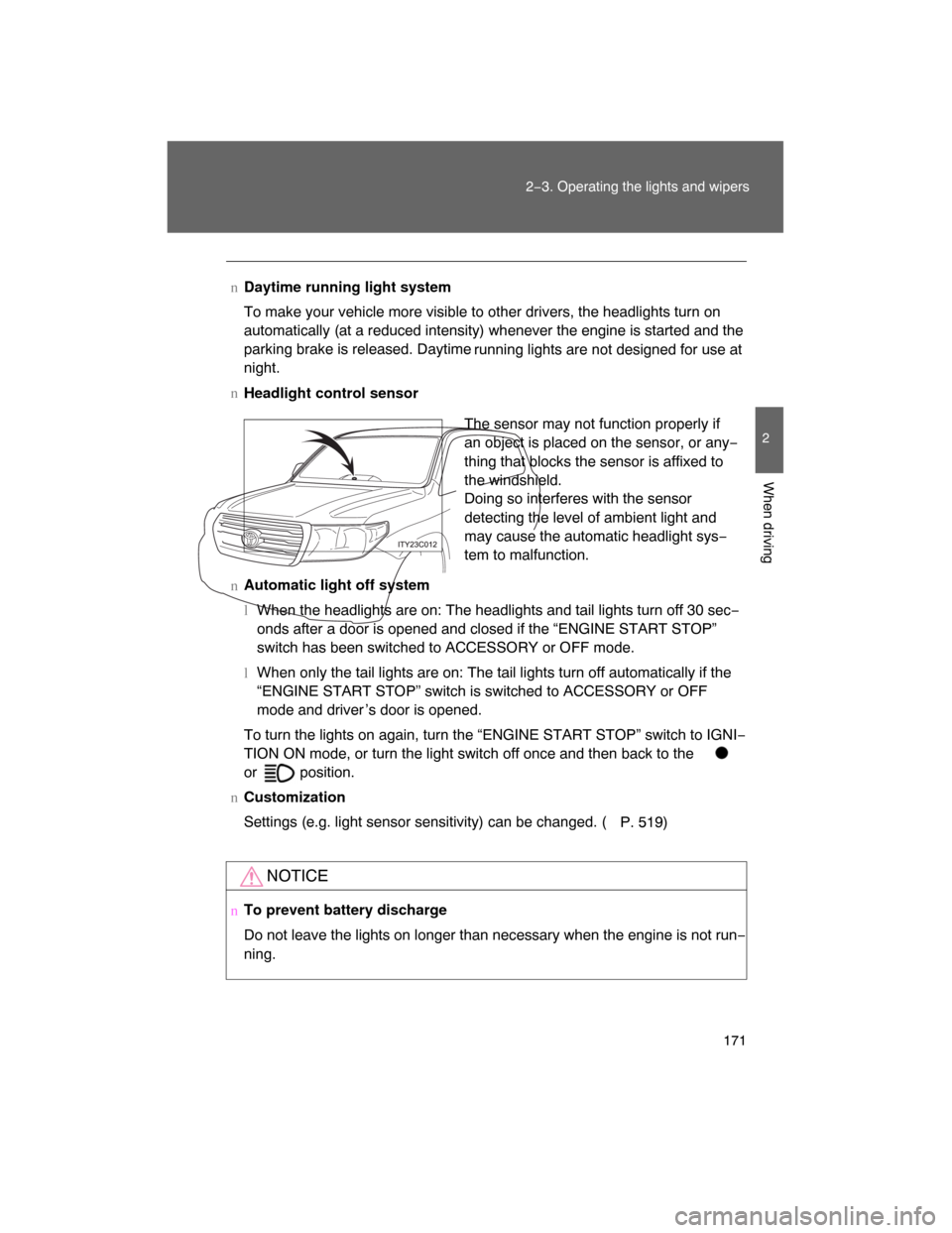Page 18 of 531

18
For your information
Main Owner ’s Manual
Please note that this manual applies to all models and explains all
equipment, including options. Therefore, you may find some explana−
tions for equipment not installed on your vehicle.
All specifications provided in this manual are current at the time of
printing. However, because of the Toyota policy of continual product
improvement, we reserve the right to
make changes at any time with−
out notice.
Depending on specificati
ons, the vehicle shown in the illustration may
differ from your vehicle in terms of equipment.
Accessories, spare parts and modification of your Toyota
A wide variety of non−genuine spare parts and accessories for Toyota
vehicles are currently available in
the market. You should know that
Toyota does not warrant these prod ucts and is not responsible for
their performance, repair, or replacement, or for any damage they
may cause to, or adverse effect they may have on, your Toyota vehi−
cle.
This vehicle should not be modi
fied with non−genuine Toyota prod−
ucts. Modification with non−genuine Toyota products could affect its
performance, safety or durability
, and may even violate governmental
regulations. In addition, damage or performance problems resulting
from the modification may not be covered under warranty.
Page 30 of 531
31
1−2. Opening, closing and locking the doors
1
Before driving
nSwitching the door unlock function
If it is possible to set which doors the entry function unlocks.
Turn the “ENGINE START STOP” switch OFF.
When the indicator on the key surface is turned off, press and hold
, or for approximately 5 seconds while pressing
on the key.
The setting changes each time an operation is preformed, as shown below.
(When changing the setting continuously, release the buttons, wait for at least
5 seconds, and repeat step 2.)
STEP1
STEP 2
Multi−information
displayUnlocking function Beep
Hold the driver ’s door han−
dle to unlock only the
driver ’s door.Exterior: Beeps three
times
Interior: Pings once
Hold either door handle to
unlock all doors.
Exterior: Beeps twice
Interior: Pings once
Page 35 of 531

36 1−2. Opening, closing and locking the doors
*1: A message will be shown on the multi−information display in the instru−
ment cluster.
*2: If the engine does not start when the electronic key is inside the vehicle,
the electronic key battery may be depleted or there may be difficulties
receiving signal front the key. (
P. 481)
nIf the smart key system does not operate properly
l
Locking and unlocking the doors: Use the mechanical key. ( P. 481)
lStarting the engine: P. 150
n
P. 410
nCustomization that can be configured at Toyota dealer
Settings (e.g. smart key system) can be changed. (Customizable features
P. 519)
AlarmSituation Correction procedure
Interior alarm
pings once and
exterior alarm
sounds 3 times
*1
The driver ’s door was
closed after the key was
carried outside the vehicle,
and the “ENGINE START
STOP” switch was not
turned OFFTurn the “ENGINE
START STOP” switch
OFF and close the
driver ’s door again
An occupant carried the
electronic key outside the
vehicle and closed the
door while the “ENGINE
START STOP” switch was
not OFF
Bring the electronic
key back into the vehi−
cle
Page 142 of 531

144 2−1. Driving procedures
CAUTION
nWhen driving on slippery road surfaces
lSudden braking, acceleration and steering may cause tire slippage and
reduce your ability to control the vehicle, resulting in an accident.
lSudden changes in engine speed, such as engine braking caused by up−
shifting or down−shifting, may cause the vehicle to skid, resulting in an
accident.
lAfter driving through a puddle, lightly depress the brake pedal to make
sure that the brakes are functioning properly. Wet brake pads may prevent
the brakes from functioning properly. If the brakes on only one side are wet
and not functioning properly, steering control may be affected, resulting in
an accident.
nWhen shifting the shift lever
Be careful not to shift the shift lever with the accelerator pedal depressed.
This may lead to unexpected rapid acceleration of the vehicle that may
cause an accident and result in death or serious injury.
nWhen the vehicle is stopped
lDo not race the engine.
If the vehicle is in any gear other than “P” or “N”, the vehicle may acceler−
ate suddenly and unexpectedly, and may cause an accident.
lDo not leave the vehicle with the engine running for a long time.
If such a situation cannot be avoided, park the vehicle in an open space
and check that exhaust fumes do not enter the vehicle interior.
l
Always keep a foot on the brake pedal while the engine is running to pre−
vent an accident caused by the vehicle moving.
Page 169 of 531

171
2−3. Operating the lights and wipers
2
When driving
nDaytime running light system
To make your vehicle more visible to other drivers, the headlights turn on
automatically (at a reduced intensity) whenever the engine is started and the
parking brake is released. Daytime
running lights are not designed for use at
night.
n
Headlight control sensor
nAutomatic light off system
lWhen the headlights are on: The headlights and tail lights turn off 30 sec−
onds after a door is opened and closed if the “ENGINE START STOP”
switch has been switched to ACCESSORY or OFF mode.
lWhen only the tail lights are on: The tail lights turn off automatically if the
“ENGINE START STOP” switch is switched to ACCESSORY or OFF
mode and driver ’s door is opened.
To turn the lights on again, turn the “ENGINE START STOP” switch to IGNI−
TION ON mode, or turn the light switch off once and then back to the
or
position.
nCustomization
Settings (e.g. light sensor sensitivity) can be changed. (
P. 519)
NOTICE
nTo prevent battery discharge
Do not leave the lights on longer than necessary when the engine is not run−
ning.
The sensor may not function properly if
an object is placed on the sensor, or any−
thing that blocks the sensor is affixed to
the windshield.
Doing so interferes with the sensor
detecting the level of ambient light and
may cause the automatic headlight sys−
tem to malfunction.
Page 252 of 531
256
3−1. Using the air conditioning system and defogger
Rear window and outside rear view mir ror defoggers
nThe rear window and outside rear vi ew mirror defoggers can be oper�
ated when
The “ENGINE START STOP” switch is in IGNITION ON mode.
CAUTION
nWhen the outside rear view mirror defoggers are on
Do not touch the rear view mirror surfaces, as they can become very hot and
burn you.
These features are used to defog the rear window, and to remove
raindrops, dew and frost from the outside rear view mirrors.
With navigation system
On/off
The defoggers will automati−
cally turn off after 15 to 225
minutes. The operation time
changes according to the
ambient temperature and vehi−
cle speed. Pressing the switch
again also turns the defoggers
off.
Without navigation system
Page 258 of 531
262 3−2. Using the audio system
RDS (Radio Data System)
This feature allows your radio to receive station identification informa−
tion and program information (classic
al, jazz, etc.) from radio stations
which broadcast this information.
n
Receiving RDS broadcasts
Press “ ” or “” on the during FM reception.
The type of program changes each time the button is pressed.
lROCK
l
EASYLIS (Easy listening)
lCLS/JAZZ (Classical music and Jazz)
l
R & B (Rhythm and Blues)
l
INFORM (Information)
lRELIGION
l
MISC (Miscellaneous)
l
ALERT (Emergency messages)
If the system receives no RDS stations, “NO PTY” appears on the display.
Press , or “ ” or “ ” on .
The radio seeks scans the station by the relevant program type.
If no radio station of that type is found, “NOTHING” appears on the
display.
nDisplaying radio station names
Press .
STEP1
STEP 2
Page 265 of 531
269
3−2. Using the audio system
3
Interior features
Switching the display
Press .
Each time the button is pressed, the display changes in the order of Track
no./Elapsed time
CD title
Track name.